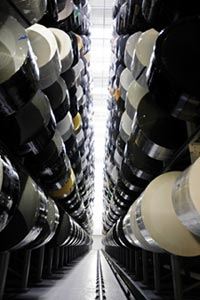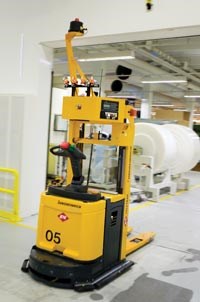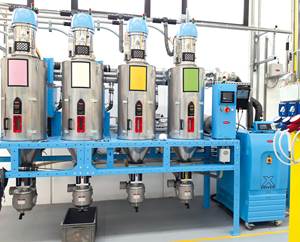Robots Manage Logistics For Entire Packaging Plant
Inventory management may be too important to be left to people.
Inventory management may be too important to be left to people. Faerch Plast A/S, a mid-sized Danish thermoformer of food trays, decided five years ago to take all human error out of storing and handling its wide array of thermoformed food trays. Faerch, which turns 40 next year, extrudes an extensive sheet inventory that includes nine colors of APET sheet, 11 colors of PS, five colors of PP, and clear PLA for approximately 900 different tray products. Certain shapes and colors are dedicated to certain customers and product lines. It’s a lot to keep track of.
“Roll storage was a logical place to begin the transition to robots,” recalls Henning Sandal, technical director, who was in charge of developing automated inventory management five years ago. The move was designed to keep pace with expansion of the company’s extrusion and thermoforming plants in Holstebro, Denmark. Faerch Plast has yearly revenues above 200 million Euros and is growing rapidly. This year it opened its first satellite plant, in the Czech Republic. Yet it employs fewer than 500 people, largely due to its reliance on robots.
AUTOMATED ROLL STORAGE
The roll-storage area looks like a scaled-up version of the stacks in a public library—only it’s four stories (over 80 ft) high. Each of the four storage walls is two rolls of film deep by 35 rolls wide by 11 rolls high. The area holds over 3000 rolls. People don’t enter here at all.
Two ladder-like picker robots slide up, down, and sideways over the storage walls of rolls. They put recently produced rolls away for later use, and remove rolls for forming on a first-in/first-out basis. The picker robots are built by Swisslog AG in Switzerland (U.S. office in Newport News, Va.).
Each roll is identified by a barcode giving production date and time, gauge, resin, and color. When a roll comes out of storage, it is delivered by a human driving a forklift truck to the thermoforming machine. But the human is double-checked by the computer controls on the thermoformer, which won’t allow it to form the wrong sheet for that job.
ROBOTIC FORKLIFTS
Faerch’s next step was to deploy specialized delivery robots around the plant. There are six battery-powered AGV (automated guided vehicle) robots from E&K Automation GmbH in Rosengarten, Germany. AGVs move noiselessly around the plant, picking up boxes of finished trays from forming machines and taking them to a computerized central storage area. The AGVs navigate around the plant with a laser guidance system. A rotating laser on the AGV “sees” fixed reflectors on the route and triangulates from these to establish its position. This makes route design far more flexible than if the robots followed a fixed track in the floor.
ROBOTS CONTROL REGRIND
The latest step in Faerch’s automation applied the AGVs to handling regrind collection. A mechanical robot on each thermoforming machine puts rolls of web skeletons into a bin. The bins are taken by AGVs, still following the material barcodes, and put into a feeder going through the floor to a grinder on a lower level, dedicated to that particular resin, and granulate is blown into a dedicated silo. “If the barcode is wrong, the grinder won’t take it,” Sandal explains.
“One robot replaces at least two people in 24 hr,” Sandal notes, though no jobs were lost to robots. “We are growing rapidly, so we just don’t hire people for those jobs.”
Related Content
High-Capacity Bulk Bag Discharger Can Be Moved Around
Equipped with a flexible screw conveyor, unit enables rapid, dust-free discharging and conveying of bulk solid materials at multiple plant locations.
Read MoreDeflection Elbows Eliminate Streamers for Large Film Processor
New elbows eliminate troublesome streamers to increase productivity at leading blown film processor.
Read MoreNew Pump Rewrites Conveying Rules
NPE2024: Smart Pump technology brings more flexibility and finesse to resin conveying.
Read MoreFinding Efficiencies in How Components Work Together
Auxiliary systems are vital to the proper functioning of a plastic processing line, and they can be a source of major cost and efficiency improvements.
Read MoreRead Next
Lead the Conversation, Change the Conversation
Coverage of single-use plastics can be both misleading and demoralizing. Here are 10 tips for changing the perception of the plastics industry at your company and in your community.
Read MoreFor PLASTICS' CEO Seaholm, NPE to Shine Light on Sustainability Successes
With advocacy, communication and sustainability as three main pillars, Seaholm leads a trade association to NPE that ‘is more active today than we have ever been.’
Read MoreMaking the Circular Economy a Reality
Driven by brand owner demands and new worldwide legislation, the entire supply chain is working toward the shift to circularity, with some evidence the circular economy has already begun.
Read More























